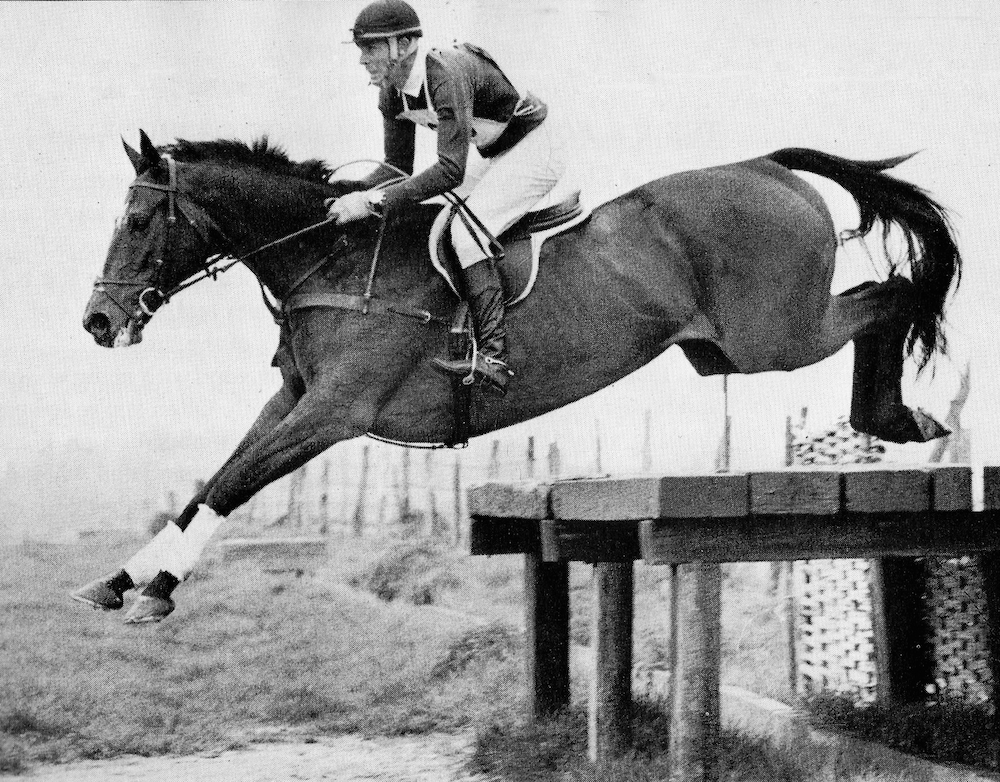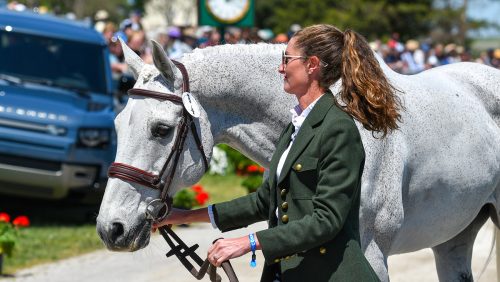In 1962, Bill Steinkraus, then the captain of the U.S. Equestrian Team, wanted a saddle that would give him a closer feel of the horses that he rode. He wanted to feel their movements through his seat and legs. He wanted them to feel what he was doing.
Mr. Steinkraus turned to the French luxury goods company Hermès to build his new saddle. With his help, Hermès designed the first close-contact saddle, which became known as the Steinkraus Hèrmes. They used a racing exercise saddle tree and the finest leather. The wooden trees were made by local artists and then returned to the Hermes shop to have the saddles built around them. The new saddle weighed a mere 10 pounds.
With the exception of a slight dip directly in the center of the seat, the saddle was perfectly flat (Mr. Steinkraus explained, recently, that to have the proper balance on a horse, one must be sitting in the center of the saddle). It had no knee rolls, blocks, or suede. Each saddle had a serial number stamped under the left skirt and if you contacted Hermès, they could tell you when the saddle was made and by what saddle maker.
The first three Steinkraus Hermès saddles belonged to Bill Steinkraus, Dave Kelley and Frank Chapot (in that order).
The Miller’s catalog was the first place that I saw the new saddle. It was beautiful but had the high price of $300. I dreamed of having one. When I saw my fellow Virginian Rodney Jenkins riding in a Hermès, I HAD to have one. Rodney was one of my heroes. He had the first and only Hermès in Virginia in 1963.
“Her–mees” is what we all called them. Although I know better now, I still call them “Her-mees.” I’m betting that most of the people that got their first one in the ‘60s or ‘70s, do the same. When I was speaking with Mr. Steinkraus recently, I found myself correcting what I was saying after I started to say “Her-mees”, to the correct “Air-MEHZ.”

Bill Steinkraus on Snowbound in his namesake Hermès.
On the first Sunday of December in 1963, my parents and I ventured to Richmond, Va., from our farm in Hampton for the Virginia Horse Shows Association annual meeting and the high score awards banquet. My pony Johnny Reb had been small pony champion of Virginia, and my father had a Board of Directors meeting.
As we were leaving the Jefferson Hotel to return home, we ran into Arthur Franklin, who owned the nearby tack shop known as Jeter’s Saddlery. We made arrangements to go to the store (even though it was not normally open at 6 p.m. on a Sunday). We did most of our business at Jeter’s so the manager, Dicky Kelly, was happy to meet us. Although I was just 10 years old, I was obsessed with beautiful tack. Whenever we went to Jeter’s, I was allowed to roam the store and the back storage room at will.
ADVERTISEMENT
On this particular evening as I meandered through the back room, I saw a brand new Hermès saddle sitting on a rack. It was dark and streaked from dying, but I was in love! For the time that the Steinkraus Hermès had been out, I had been drooling over it in the Miller’s catalog. Bill Steinkraus was my hero. Anything having to do with the U.S. Equestrian Team fascinated me (I was sure that I was going to be on the team when I turned 18). I HAD to have a Hermès saddle.
The Hermès at Jeter’s that night had been ordered by Frances Rowe for Joan Boyce. The serial number under the skirt was 942. It was the second one in Virginia (Rodney’s being the first). Jeter’s had dyed it, and the dye job wasn’t good, so Frances had refused this particular saddle and another was ordered for Joan.
Even back then, if I wanted something I charged ahead to make my own deals. I asked Mr. Kelly how much the Hermès cost. He said that the original price had been $300 but because it had a bad dye job, he would take $250. That was still a lot of money for a saddle in 1963 but after much begging, pleading and convincing, my parents bought it for me. I was one very lucky, very happy young girl.
As soon as I got home that night, I oiled my new saddle with Fiebing’s neatsfoot oil and then soaped it with a natural sponge and Belvoir glycerin saddle soap. In the upcoming weeks, I oiled it several times more and soaped it many, many times. The streaks were now gone, and the beautiful leather on the skirts was as soft as a pair of gloves. The pigskin seat was just a tad lighter in color than the rest of the saddle—as it should have been. My Hermès was beautiful! I kept it in my bedroom so I could gaze at it until I fell asleep each night.

Marianne Taylor on Country Combo, owned by Penny Jennings, at Warrenton Pony Show in 1971. Photo by Douglas Lees
I rode every pony and horse in that saddle (until I got a second one the next year). I rode as many as 10 a day. Every day. Soon, my saddle was so broken-in and soft that the skirt would roll up under my leg—just like Rodney’s—and to me, that was very cool.
My Hermès fit 12.2 small ponies, 17.0-hand horses, and everything in between. It sat perfectly on a horse with a set of high withers or a round-backed pony with no withers. It was beautifully balanced—it didn’t throw me forward or backward. I never had to use a pommel pad or a bump pad. I could feel every breath a horse took and make adjustments on the flat and over fences with a simple squeeze of my lower leg or slight change of my seat. For the rest of my career, which ended in 1996, I never rode in another make of saddle.
There are many, like me, that are still devoted to their original Hermès saddles. Judy Richter said, “I still ride in my Steinkraus Hermès. I like feeling close to the horse. It’s worn but the tree is still good. My good friend and then client, Christophe de Menil, called from the store in Paris early in the ’70’s. ‘What size’—I thought she’d say gloves—‘saddle do you take?’ The rest is history.”

Judy Richter on Freedom, riding in her Hermès.
ADVERTISEMENT
The Steinkraus Hermès became the saddle of choice for most of the “A” show professionals, amateurs, and juniors of the ‘60s, ‘70s, and ‘80s. I don’t know the number of Olympic medals, high score awards, major championships, or equitation finals that have been won in a Hermès, but it is a slew. I know of at least three show jumping gold medals that have been won by riders using a Hermès—two individual golds (Bill Steinkraus on Snowbound in 1968 and Joe Fargis on Touch Of Class in 1984) and the team gold in 1984, when all four riders rode in a Hermès. Mike Plumb, who won two gold medals, three team silver and individual silver in the Olympic Games in eventing, used a Hermès.
 Mike Plumb riding Free And Easy in 1972 in a Hermès. Photo by Mark Fiennes
Mike Plumb riding Free And Easy in 1972 in a Hermès. Photo by Mark Fiennes
Joe Fargis won the individual and team gold medal in the 1984 Los Angeles Olympic Games plus a team silver medal in the 1988 Seoul Olympic Games. He still rides and shows in a Steinkraus Hermès. He told me that was the only saddle that he’s ridden in since the beginning. Joe said, “I’ve always believed less is more. The Hermès saddle is very simple. It does not lock you in, and that is one of the nicest things about it.”
Melanie Smith Taylor, who was with Fargis on that 1984 gold medal Olympic team, also still has her Hermès. “My Hermès sits in my house in my office. It sits on a saddle rack on the flag saddle pad under pictures from L.A.,” she said.
Rita Timpanaro tells a great story about having her Hermès stolen right before she was to ride in the 1966 AHSA Medal Finals. “When I started riding, I rode in my dad’s saddle. I had different saddles until I was 12 when I got a Hermès. In 1966, at the Medal Finals, I went to mount and my groom, who often joked with me, told me that my saddle was stolen. I just remember telling him not to joke around. But it was! Wayne Carroll, my trainer, went to Carol Hofmann [Thompson], who graciously lent me her Hermès. I won the AHSA Medal Finals riding in Carol’s Hermès!”

Rita Timpanaro on Nibbles winning the first USET Medal Class at Ox Ridge in 1966. Photo courtesy of Rita Timpanaro
Years later, Rita visited Carol. “In 1995, in her closet, there sat the Hermès that I won in!” she said. “She said that she could never part with it after my win. You could really feel the horse in a Hermès, and yes, I did get another one after the Finals.”
Thank you to Bill Steinkraus for designing a saddle that so many of us used and loved. I still have my two 50-plus-year-old Steinkraus Hermès saddles. If I ever rode again, it’d be in one of those saddles.















